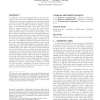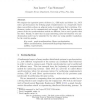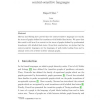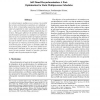257 search results - page 3 / 52 » Destructors, finalizers, and synchronization |
OOPSLA
2004
Springer
13 years 11 months ago
2004
Springer
It is difficult to write programs that behave correctly in the presence of run-time errors. Existing programming language features often provide poor support for executing clean-u...
ACSD
2009
IEEE
14 years 17 days ago
2009
IEEE
The synchronous programming paradigm simplifies the specification and verification of reactive systems. However, synchronous programs must be often implemented on architectures...
ENTCS
2006
13 years 5 months ago
2006
We compare the expressive power of Hoare (i.e., CSP style) and Milner (i.e., CCS style) synchronizations for defining graph transformations in a framework where edges can perform ...
ENTCS
2002
13 years 5 months ago
2002
Morvan and Stirling have proved that the context-sensitive languages are exactly the traces of graphs defined by transducers with labelled final states. We prove that this result ...
IPPS
1996
IEEE
13 years 10 months ago
1996
IEEE
In a shared-memory multiprocessor system, it is possible that certain synchronization operations are redundant -that is, their corresponding sequencing requirements are enforced c...




